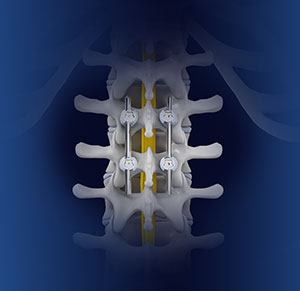
Spinal fusion
Spinal fusion is a surgical procedure that involves the permanent connection of two or more bones in the spine. This is achieved using bone grafts, metal rods, screws, and other stabilizing materials. The primary goal is to reduce pain and improve spinal stability.
Why Is Spinal Fusion Performed?
- Herniated discs that have not responded to other treatments
- Scoliosis or spinal deformities requiring correction
- Spondylolisthesis, where one vertebra slips forward over another
- Chronic lower back pain that hasn’t improved with non-surgical treatments
Types of Spinal Fusion Surgery
This approach involves accessing the spine from the front (abdomen) to remove a damaged disc and insert a bone graft for fusion.
In this method, the surgeon reaches the spine through the back and removes the problematic disc before fusing the vertebrae.
Similar to PLIF but performed from the side, TLIF minimizes the risk of nerve damage and allows for a more stable fusion.
This technique involves approaching the spine from the side to insert bone grafts and stabilizing hardware.
This procedure is performed on the neck region to address conditions affecting the cervical spine, such as degenerative disc disease and stenosis.
The Spinal Fusion Procedure: Step-by-Step Breakdown
- Stop smoking, as it can slow down bone healing.
- Avoid certain medications that can increase bleeding.
- Maintain a healthy diet to promote recovery.
- Anesthesia: The patient is placed under general anesthesia ensure comfort.
- Incision: Depending on the technique, the incision may be made in the back, abdomen, or side.
- Bone Grafting: A bone graft is placed between the affected vertebrae to promote fusion.
- Stabilization: Screws, rods, or plates are used to hold the bones in place while they heal.
- Closure: The incision is closed and patient is taken to recovery.
- Hospital Stay: Between 2 to 5 days post-surgery
- Pain Management: Medications and physical therapy can aid recovery
- Limited Mobility: Avoid heavy lifting and excessive movement during the initial weeks
- Full Recovery: It may take 6 to 12 months for the bones to fully fuse
Potential Risks and Complications
Despite sterile environments, infections can sometimes occur post-surgery. Antibiotics and proper wound care help prevent this.
Patients are advised to move regularly and wear compression garments to reduce the risk of blood clots.
Although rare, there is a small risk of nerve injury that can cause numbness or weakness.
In some cases, the bones do not fuse properly, leading to persistent pain and the need for additional surgery.
Fusion can sometimes increase stress on adjacent vertebrae, leading to degeneration over time.
Benefits of Spinal Fusion Surgery
For individuals suffering from chronic pain, spinal fusion can significantly reduce discomfort and improve mobility.
By eliminating movement between unstable vertebrae, the spine becomes more stable, reducing the likelihood of further injuries.
Many patients experience a significant improvement in their ability to perform daily activities without pain.
Recovery and Rehabilitation: What to Expect
- Stretching to maintain mobility
- Core strengthening to support the spine
- Low-impact activities like swimming or walking
- Avoid Heavy Lifting: Do not lift objects heavier than 10 pounds.
- Maintain Proper Posture: Keep your spine aligned to prevent additional stress.
- Healthy Diet: Nutrient-rich foods promote faster bone healing.
Conclusion
Spinal fusion is a well-established procedure that provides long-term relief for individuals with severe spinal conditions. While the recovery process requires patience and commitment, the benefits of increased stability and reduced pain make it a worthwhile option for many patients.Contact Us
If you are considering spinal fusion, consult with a qualified spine specialist to discuss your options. With the right guidance, you can take proactive steps toward a healthier, pain-free life.Schedule your Consultation with Dr. Ritesh Nawkhare
